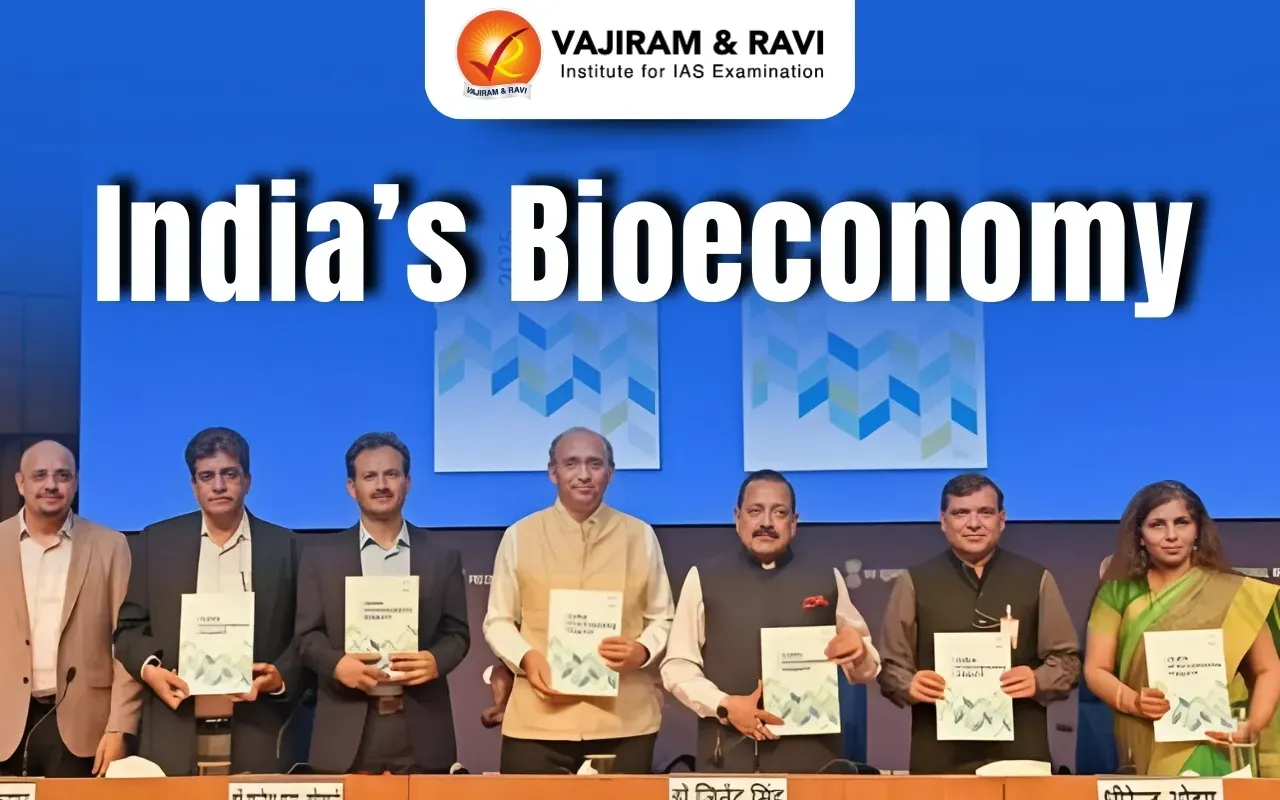What’s in Today’s Article?
- India’s Bioeconomy Latest News
- Bioeconomy
- Growing Footprint of India’s Bioeconomy
- BioE3 Policy: Boosting India’s Bioeconomy
- ther Initiatives & Policy Push
- Challenges and Way Forward
- India’s Bioeconomy FAQs
India’s Bioeconomy Latest News
- The India BioEconomy Report 2024, released by the Department of Biotechnology, estimates India’s bioeconomy to be worth over $165 billion, contributing 4.2% of GDP.
- The report highlights significant growth potential, projecting the sector to reach $300 billion by 2030 and $1 trillion by 2047.
Bioeconomy
- Bioeconomy refers to the industrial use of biological resources (plants, animals, microorganisms) and natural biological processes for producing goods and services.
Traditional and Expanding Applications
- Biological resources have long been used in healthcare, pharmaceuticals, and agriculture.
- Their use is now expanding to fuels, textiles, plastics, construction materials, and chemicals due to their renewability, cost-effectiveness, and sustainability.
Sustainable Alternatives
- Ethanol, produced via fermentation of sugarcane or corn, is replacing hydrocarbon-based fuels.
- Biotechnology enables biomedicines and synthetic biology, allowing the design of microorganisms with specific traits.
Scope for Rapid Growth
- The economic use of biological resources is still in its early stages but has vast untapped potential.
- With advancements in biotechnology and sustainability, the bioeconomy is expanding rapidly.
Growing Footprint of India’s Bioeconomy
- India’s bioeconomy nearly doubled in five years, from $86 billion (2020) to $165 billion (2024).
- Growth has surpassed the initial target of $150 billion by 2025.
- The number of bioeconomy companies increased by 90%, from 5,365 (2021) to 10,075 (2024), and is projected to double by 2030, creating 35 million jobs.
Sector-Wise Contributions
- The sector now contributes 4.25% to GDP with a CAGR of 17.9% in the last four years.
- Industrial sector (biofuels, bioplastics) contributed $78 billion (~47%).
- Pharma sector contributed 35%, with vaccines as the key driver.
- Fastest-growing segment (2024): Research & IT, including biotech software, clinical trials, and bioinformatics.
Regional Disparities
- Five states (Maharashtra, Karnataka, Telangana, Gujarat, Andhra Pradesh) generated over two-thirds of bioeconomy value.
- Eastern & Northeastern regions contributed less than 6%.
Challenges & Future Prospects
- Sustaining high growth will require innovation, scaling-up incentives, and policy reforms.
- Addressing regional imbalances is crucial.
- While India’s bioeconomy (4.2% of GDP) is comparable to China & the US, it lags behind Spain & Italy (20% of GDP).
BioE3 Policy: Boosting India’s Bioeconomy
- Launched in 2024, the BioE3 policy (Biotechnology for Economy, Environment, and Employment) aims to make India a global hub for bio-manufacturing and R&D in biotechnology.
Key Objectives
- Strengthen bio-manufacturing in areas like:
- Bio-based chemicals & enzymes
- Functional foods & precision biotherapeutics
- Marine & space biotechnology
- Climate-resilient agriculture
- Foster a network of universities, research institutions, start-ups, and industries.
Implementation
- Assam became the first state to adopt the BioE3 framework, signaling nationwide expansion.
- New initiatives include Bio-AI Hubs, Bio Foundries, and Bio-Enabler Hubs for integrating advanced tech into biomanufacturing.
- Address policy bottlenecks to unlock the sector’s full potential.
Other Initiatives & Policy Push
- New initiatives include Bio-AI Hubs, Bio Foundries, and Bio-Enabler Hubs for integrating advanced tech into biomanufacturing.
Boosting Startups & Innovation
- India’s biotech startups grew from 50 in 2014 to over 10,075 in 2024.
- The BioSaarthi mentorship program was launched to support startups with global mentorship, leveraging Indian diaspora expertise.
- Public-private partnerships have fueled sectoral expansion and innovation.
Breakthroughs in Biotechnology
- Development of Nafithromycin, India’s first indigenous antibiotic for respiratory diseases.
- Successful gene therapy trials for hemophilia.
- Completion of India’s whole genome sequencing project, mapping 10,074 individuals across 99 communities to revolutionize precision medicine.
Space Biotechnology & Future Prospects
- Collaboration between the Department of Biotechnology and ISRO to advance space biology and medicine.
- Biotechnology will play a key role in astronaut health and space research as India prepares for its first space station.
R&D Investment Surge
- India’s Gross Expenditure on R&D (GERD) doubled, from ₹60,196 crore in 2013-14 to ₹1,27,381 crore in 2024.
- This funding push underscores the government’s commitment to scientific research and innovation.
Challenges and Way Forward
- India has strong existing capabilities in some biotech fields, making commercialization easier.
- However, regulatory challenges remain, especially in genetically modified (GM) crops, which could enhance agricultural productivity.
Recommendations for Future Growth
- Establish a National Bio Economy Mission.
- Implement single-window regulatory mechanisms to streamline biotech innovations.
India’s Bioeconomy FAQs
Q1. What is India’s bioeconomy?
Ans. It involves industrial use of biological resources for pharmaceuticals, biofuels, and biotech innovations.
Q2. How fast is India’s bioeconomy growing?
Ans. It grew from $86 billion in 2020 to $165 billion in 2024, targeting $1 trillion by 2047.
Q3. What is the BioE3 policy?
Ans. Launched in 2024, it boosts biotech R&D, bio-manufacturing, and sustainable innovations.
Q4. Which sectors drive India’s bioeconomy?
Ans. Key contributors are biofuels, pharmaceuticals, biotech startups, and research-driven sectors.
Q5. What challenges hinder bioeconomy growth?
Ans. Regulatory issues, regional disparities, and limited commercialization of biotech innovations remain key hurdles.
Last updated on June, 2025
→ UPSC Notification 2025 was released on 22nd January 2025.
→ UPSC Prelims Result 2025 is out now for the CSE held on 25 May 2025.
→ UPSC Prelims Question Paper 2025 and Unofficial Prelims Answer Key 2025 are available now.
→ UPSC Calendar 2026 is released on 15th May, 2025.
→ The UPSC Vacancy 2025 were released 1129, out of which 979 were for UPSC CSE and remaining 150 are for UPSC IFoS.
→ UPSC Mains 2025 will be conducted on 22nd August 2025.
→ UPSC Prelims 2026 will be conducted on 24th May, 2026 & UPSC Mains 2026 will be conducted on 21st August 2026.
→ The UPSC Selection Process is of 3 stages-Prelims, Mains and Interview.
→ UPSC Result 2024 is released with latest UPSC Marksheet 2024. Check Now!
→ UPSC Toppers List 2024 is released now. Shakti Dubey is UPSC AIR 1 2024 Topper.
→ Also check Best IAS Coaching in Delhi













